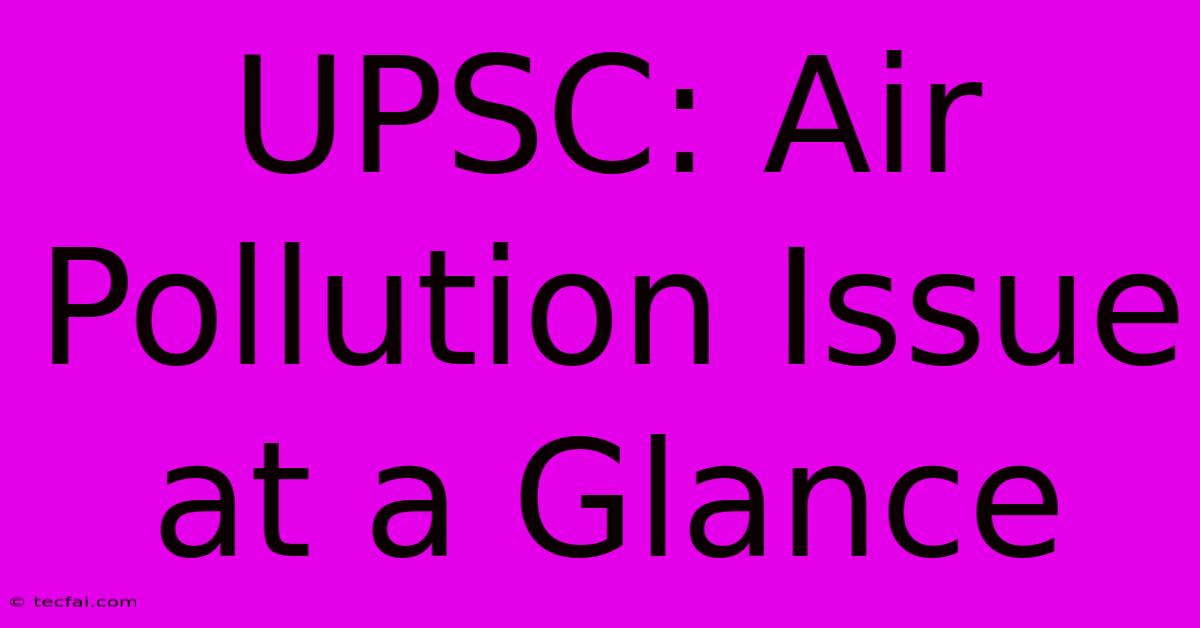UPSC: Air Pollution Issue At A Glance

Discover more detailed and exciting information on our website. Click the link below to start your adventure: Visit Best Website tecfai.com. Don't miss out!
Table of Contents
UPSC: Air Pollution Issue at a Glance
Air pollution has emerged as a significant concern in India, impacting public health, the environment, and the economy. Understanding its multifaceted nature is crucial for aspirants preparing for the UPSC examination. This article provides a concise overview of the issue, highlighting key aspects relevant to the exam.
Sources of Air Pollution in India
India faces a complex web of air pollution sources, broadly categorized as:
1. Vehicular Emissions:
- Major Contributor: A rapidly growing vehicle population, particularly in urban areas, contributes significantly to air pollution through exhaust fumes containing particulate matter (PM2.5 and PM10), nitrogen oxides (NOx), and carbon monoxide (CO).
- Fuel Quality: The use of low-quality fuels further exacerbates the problem.
- Lack of Enforcement: Inadequate enforcement of emission standards and vehicle maintenance regulations adds to the challenge.
2. Industrial Emissions:
- Industries: Industries, especially those in the power, manufacturing, and construction sectors, release harmful pollutants like sulfur dioxide (SO2), NOx, and particulate matter.
- Unregulated Industries: Many small and medium-sized industries often lack adequate pollution control measures.
- Outdated Technology: The use of outdated and inefficient technologies contributes to higher emission levels.
3. Construction Activities:
- Dust Generation: Construction projects generate substantial amounts of dust particles, which are major components of PM10.
- Lack of Mitigation Measures: Often, insufficient measures are taken to mitigate dust pollution during construction activities.
4. Agricultural Practices:
- Burning of Crop Residue: The practice of burning crop residue, particularly in the northern plains, significantly contributes to air pollution, especially during the harvesting season.
- Use of Pesticides: The use of certain pesticides can also contribute to air pollution.
5. Domestic Fuel Burning:
- Solid Fuels: The burning of solid fuels like wood, coal, and dung cakes in households, especially in rural areas, releases harmful pollutants into the atmosphere.
Health Impacts of Air Pollution
The severe health consequences of air pollution are well documented:
- Respiratory Diseases: Increased incidence of asthma, bronchitis, and other respiratory illnesses.
- Cardiovascular Diseases: Higher risk of heart attacks, strokes, and other cardiovascular problems.
- Cancer: Association with various types of cancer, particularly lung cancer.
- Premature Mortality: Air pollution significantly contributes to premature deaths.
Environmental Impacts of Air Pollution
- Acid Rain: Air pollutants like SO2 and NOx contribute to acid rain, damaging ecosystems and infrastructure.
- Climate Change: Air pollutants such as black carbon and methane contribute to climate change.
- Reduced Visibility: Air pollution significantly reduces visibility, impacting aviation and other sectors.
- Damage to Crops and Vegetation: Air pollutants can harm crops and other vegetation, affecting agricultural productivity.
Government Initiatives to Combat Air Pollution
The Indian government has implemented several measures to tackle air pollution, including:
- National Clean Air Programme (NCAP): Aimed at reducing particulate matter concentration by 20-30% by 2024.
- Bharat Stage (BS) Emission Norms: Regulations for vehicular emission standards, gradually transitioning to stricter norms (currently BS-VI).
- Promoting Clean Energy: Initiatives to promote the use of renewable energy sources, such as solar and wind power.
UPSC Exam Relevance
The UPSC exam frequently tests candidates' understanding of environmental issues, including air pollution. Aspirants should focus on:
- Sources and Impacts: A thorough understanding of the various sources of air pollution and their health and environmental consequences is crucial.
- Government Policies: Knowledge of government policies and initiatives to address air pollution is essential.
- International Collaborations: Understanding India's participation in international efforts to combat air pollution is also important.
- Sustainable Solutions: Familiarity with sustainable solutions and technologies to mitigate air pollution.
By focusing on these key areas, aspirants can effectively prepare for the UPSC examination and contribute to informed discussions about this critical issue. Remember to incorporate relevant case studies and data from credible sources to strengthen your understanding. This holistic approach will enable you to answer questions comprehensively and confidently.

Thank you for visiting our website wich cover about UPSC: Air Pollution Issue At A Glance. We hope the information provided has been useful to you. Feel free to contact us if you have any questions or need further assistance. See you next time and dont miss to bookmark.
Featured Posts
-
Bayern Munich Vs Augsburg 22 11 2024
Nov 23, 2024
-
Donegal Crash Emergency Services Respond
Nov 23, 2024
-
East Enders Alum Returns To Soaps
Nov 23, 2024
-
A League Preview Phoenix Vs Victory Round 5
Nov 23, 2024
-
Stream Wicked Where To Watch
Nov 23, 2024
